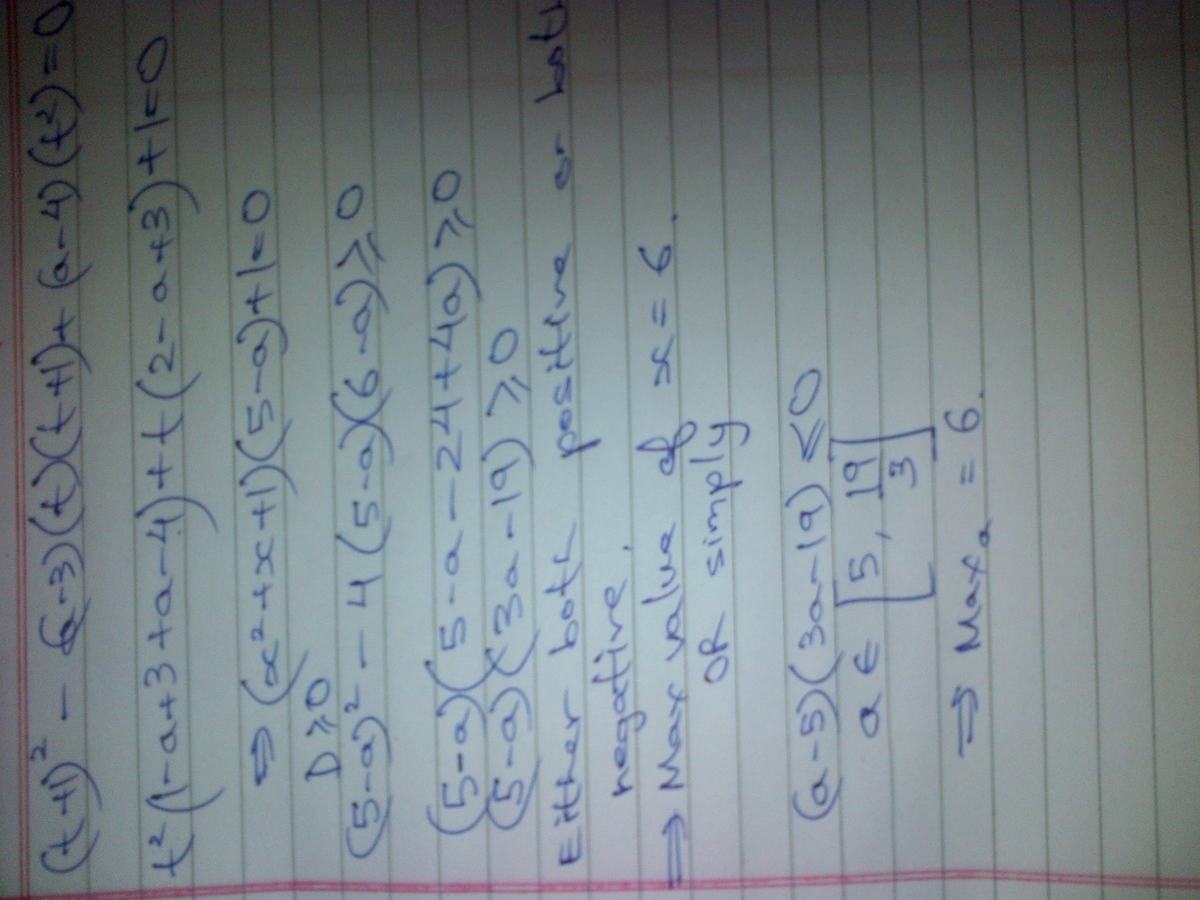JEE Quadratic#9
( x 2 + x + 2 ) 2 − ( a − 3 ) ( x 2 + x + 2 ) ( x 2 + x + 1 ) + ( a − 4 ) ( x 2 + x + 1 ) 2 = 0
Find the maximum integral value of a for which the expression has at least one real root (for x ).
The answer is 6.
This section requires Javascript.
You are seeing this because something didn't load right. We suggest you, (a) try
refreshing the page, (b) enabling javascript if it is disabled on your browser and,
finally, (c)
loading the
non-javascript version of this page
. We're sorry about the hassle.
3 solutions
x 2 + x + 1 = m , ⟹ ( x + 2 1 ) 2 + 4 3 = m
m ≥ 4 3
Given expression-
( m + 1 ) 2 − ( a − 3 ) ( m + 1 ) m + ( a − 4 ) m 2 = 0
2 m − 1 − m ( a − 3 ) = 0
m = a − 5 1
⟹ a > 5
m ≥ 4 3 , ⟹ a − 5 1 ≥ 4 3
a ≤ 3 1 9
a ∈ ( 5 , 3 1 9 ]
Same approach except found the range of value of t by assuming it to be another variable and making the discriminant positive Essentially the same
Consider the equation:
( x 2 + x + 2 ) 2 − ( a − 3 ) ( x 2 + x + 2 ) ( x 2 + x + 1 ) + ( a − 4 ) ( x 2 + x + 1 ) 2 = 0
As x 2 + x + 1 > 0 for all real x, we can divide both sides by ( x 2 + x + 1 ) 2 , resulting in this equation:
( x 2 + x + 1 x 2 + x + 2 ) 2 − ( a − 3 ) ( x 2 + x + 1 x 2 + x + 2 ) + ( a − 4 ) = 0
Let t = x 2 + x + 1 x 2 + x + 2 = 1 + x 2 + x + 1 1 .
Then 1 < t ≤ 3 7 .
The original equation therefore becomes: t 2 − ( a − 3 ) t + a − 4 = 0
Which can be factored as: ( t − 1 ) [ t − ( a − 4 ) ] = 0 .
The original equation has one real root if and only if the equation ( t − 1 ) [ t − ( a − 4 ) ] = 0 has at least one real root that satisfies 1 < t ≤ 3 7 . Since one of the roots is t = 1 , the other one must be ≤ 3 7 .
Therefore, a − 4 ≤ 3 7 , or a ≤ 3 1 9 .
The maximum integral a that satisfies this condition is a = 6 .

Let , A = x 2 + x + 2 & B = x 2 + x + 1
Again Also , Let :
t = B A = 1 + x 2 + x + 1 1 = 1 + ( x + 2 1 ) 2 + 4 3 1 t ∈ ( 1 , 3 7 ]
So required question is analogous to : Q : t 2 − ( a − 3 ) t + a − 4 = 0 finding values of 'a' for which quadratic 'Q' has at least one real root in the interval 1 to 7 / 3 , in which t=7/3 (achieve when x = − 1 / 2 ) is inclusive value and 1 is exclusive( can't achive , since 'x' can't be infinity ) .
Analysing the quadratic ' Q ' , we get it's Discriminate as positive , (discriminant can't be zero , Since if so , then a = 5 and t = 1 which is not in our domain ) Since Q ( t ) : t 2 − ( a − 3 ) t + a − 4 = 0
By analysing some graphs for this quadratic equation 'Q' , we concluded that required Condition is simply nothing but : Q ( 3 7 ) ≥ 0 a ≤ 3 1 9 = 6 . 3 3 ⌊ a ⌋ m a x = 6